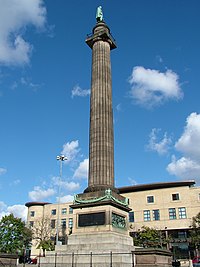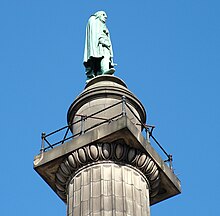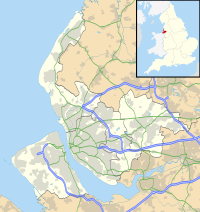Wellington's Column
| Wellington's Column | |
|---|---|
 Wellington's Column | |
| Location | Liverpool,Merseyside,England |
| Coordinates | 53°24′34″N2°58′44″W/ 53.40958°N 2.97885°W |
| OS grid reference | SJ 351 908 |
| Built | 1861–65 |
| Architect | Andrew Lawson George Anderson Lawson |
Listed Building– Grade II* | |
| Designated | 28 June 1952 |
| Reference no. | 1063784 |


Wellington's Column,or theWaterloo Memorial,is a monument to theDuke of Wellingtonstanding on the corner ofWilliam Brown StreetandLime Street,Liverpool,Merseyside,England. It is recorded in theNational Heritage List for Englandas a designated Grade II*listed building.[1]
History[edit]
After the Duke's death in 1852, in common with other cities, Liverpool decided to erect a monument to celebrate his achievements. A committee was established to organise public subscriptions, but the money was slow to come in.[2]A competition was set up in 1856 to find a designer for the column, and this was won by the architect Andrew Lawson of Edinburgh. There were further delays while a suitable site was found, with sites at the top of Duke Street andBold Street,in front of theAdelphi HotelandPrince's Parkbeing considered before the eventual location was settled on.[3]In 1861 a second competition, this time for the statue of the Duke, was won byGeorge Anderson Lawson,brother of the column's designer.[4]The design of the column and plinth closely resembles that of theMelville MonumentcommemoratingHenry Dundas,Lord Melville inSt Andrew Square, Edinburgh,[5]itself loosely modelled onTrajan's Columnin Rome.
The foundation stone was laid on 1 May 1861 by theMayor of Liverpool.There were further delays during construction of the monument due to subsidence. Although it was inaugurated on 16 May 1863 in a ceremony attended by the Mayor andSir William Brown,it was still not complete.[6]Reliefs depicting Wellington's victories and the charge at theBattle of Waterloowere still to be added and it was finally completed towards the end of 1865.[2]These delays resulted in its being "a very late example of a column-monument for Britain".[4]
Description[edit]
The foundations of the monument are inRuncornsandstone,thepedestalis ingranite,and the column itself is inDarley Dalesandstone. The overall height of the monument is 132 feet (40.2 m), the column being 81 feet (24.7 m) high and the statue 25 feet (7.6 m) high. It stands on a stepped base with a square pedestal. On each side of the pedestal is a bronze plaque; at the corners are bronze eagles joined byswagsalong the sides. Standing on the pedestal is aRoman Doricflutedcolumn. Within the column are 169 steps leading up to a viewing platform. On top of the column is a cylinder surmounted by acupolaon which the bronze statue of the Duke stands.[2]The statue is made from the melted-down bronze from cannons captured at the Battle of Waterloo.[7]The Duke holds a scroll in his right hand, and his left hand rests on the hilt of his sword.[2]
The brass plaque on the south of the pedestal is areliefdepicting the final charge at thebattle of Waterloo.On the east and west faces, the plaques bear the names of the Duke's victorious battles. The east panel lists the battles ofAssaye,Talavera,Argaum,Busaco,Roliça,Fuentes de Oñoro,Vimeiro,Ciudad Rodrigo,Oporto,andBadajoz;the west panelSalamanca,Bayonne,Vittoria,Orthez,San Sebastián,Toulouse,Nivelle,Quatre Bras,and Waterloo.[2]Also on and around the base of the monument are pre-metric standardBoard of Trademeasurements of length, the shorter ones being em Boss ed on a bronze panel. Set into the pavement is a brass strip containing the measure of 100 feet (30.5 m), and a chain of 100 links.[7]
See also[edit]
References[edit]
- ^Historic England,"Wellington Column, Liverpool (1063784)",National Heritage List for England,retrieved12 April2015
- ^abcdeCavanagh, Terry (1996),Public Sculpture of Liverpool,Public Sculpture of Britain, Liverpool: Liverpool University Press, pp. 25–28,ISBN0-85323-701-8,retrieved6 August2011
- ^Liverpool Daily Post3 May 1860
- ^abPollard, Richard;Pevsner, Nikolaus(2006),Lancashire: Liverpool and the South-West,The Buildings of England, New Haven and London: Yale University Press, p. 300,ISBN0-300-10910-5
- ^"Link to liverpoolmonuments.co.uk/statue/wellington06.html",retrieved3 September2013
- ^"Wellington's Wait".liverpoolhiddenhistory.co.uk.25 May 2014.Retrieved5 March2017.
- ^abPye, Ken (2011),Discover Liverpool,Liverpool: Trinity Mirror Media, p. 23,ISBN978-1-906802-90-5
- Columns related to the Napoleonic Wars
- Grade II* listed buildings in Liverpool
- Outdoor sculptures in Liverpool
- Monumental columns in England
- Monuments and memorials in Liverpool
- Statues of Arthur Wellesley, 1st Duke of Wellington
- Buildings and structures completed in 1865
- 1865 sculptures
- Bronze sculptures in England
- Statues in England
- Grade II* listed monuments and memorials
- Observation towers in the United Kingdom






